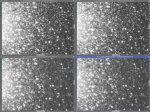I would like to bring this thread alive. I too suffer from bad columns in 16803 CCD. The cosmetic correction function does not work well. And in general, I don't want any pixel value replacement using nearby pixels. The reason is that I hope the final stacked image can be scientifically accurate. Only good data enter the final stack, and no pixel values are invented during the process.
My initial thought is to find a way for pixel rejection to simply reject those pixels. Without any cosmetic correction, this doesn't work. The values in the bad columns aren't too different from other neighboring good pixels. They don't get rejected.
My next trial is to use pixel math to replace the bad columns with 1.0. I thought then I can use the clip range parameter in image integration to reject those 1.0 pixels. This doesn't work, because after registration, those 1.0 pixels got mixed with neighboring pixels, and their resultant values can be anywhere between 0 and 1. So this trial fails again.
Any suggestions?
Hi Wei-Hao,
You may be interested in the following article:
PixInsight — Correcting Defective Lines in PixInsight
PixInsight - Advanced Image Processing. PixInsight is a modular, open-architecture, portable image processing platform available for FreeBSD, Linux, Mac OS X and Windows.
The LinearDefectDetection and LinearPatternSubtraction scripts are available on the standard PixInsight distribution. They can also be used from the WBPP script. The article documents these scripts and describes the implemented algorithms.

